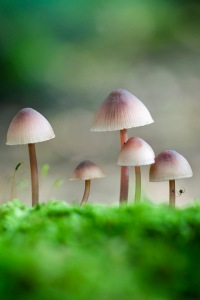* pix by Alison Pouliot
All the recent rain makes me think of the eventual return of sun … and mushrooms.
Who can go past a plate of fresh-picked mushrooms cooked with a little butter, pepper and parsley?
But my faith in fairy rings found in the field was forever trampled when Horse Whisperer author Nicholas Evans accidentally poisoned himself, his wife and his brother-in-law to the point three of them needed new kidneys.
A true story more nightmarish than any international-best seller, caused by simply mistaking deadly webcap mushrooms for tasty ceps.
Perhaps that’s the dichotomy of our relationship with the third kingdom: its so shape-shifting.
One kind of yeast you’ve got candida – another and it’s champagne.
Yet the fungi kingdom with its enormous variety of yeasts, rusts, smuts, mushrooms, moulds, mildews and toadstools includes some of the most ecologically and economically valuable organisms on earth.
People have been relying on fungi since the very first loaf of leavened bread was baked and the first tub of grapes fermented into wine.
It’s fungi that puts the pop into Pol Roger.
And it’s the source of a raft of life-saving drugs including most famously the antibiotic penicillin, as well as providing nutritious food.
Yet for all fungus provides it is woefully neglected, particularly here in Australia, as ecologist and internationally acclaimed environmental photographer, Alison Pouliot, explains.
It might be said Pouliot is on a mission to put the fun into fungi. Her delicate compositions of perfect parasols, plump puffballs and lacy corals are a symphony of the soil.
“I have looked at all the Australian legislation – as dry and dreary as it is – around biodiversity and none of it mentions fungi,” she laments.
“They are really sort of out of consciousness here, and I think that could be because we don’t have the same sort of cultural connections they have in Europe.
“The irony is we actually have way more fungi in Australia than there are in Europe.”
Close to 15,000 species of fungi have been described in Australia, but it is thought this is less than 20 per cent of the picture.
In Australia fungi are generally spoken about as being pathogenic or disease-causing and most money goes toward eliminating them rather than promoting the many benefits.
Yet, fungi is essential.
The tree we see in the backyard, Pouliot says, is really just the tip of the story.
“If you imagine putting a stocking on a stick, the mycelium – the underground vegetative part of the fungus – coats the roots and can actually extend the root system of the tree by up to 1000 times.
“It solulabises [makes soluble] things like nitrates and phosphates so the tree can absorb them, and in return the tree gives the fungus a feed of sugars, because the fungus can’t photosynthesise.
“When we look at, say, a eucalypt, we think ‘oh, it’s a tree’, but it’s not, it’s a relationship.
“With truffles it is actually a three-way relationship because you have their connection to the eucalypt, but they can’t disperse their spores unless a wallaby, bettong or some other mammal comes and digs it up, so you have this connection between three kingdoms.
“You have the eucalypt that needs the fungus to be able to absorb nutrients, you have the fungus that needs the bettong.
“It is this beautiful relationship.”
Fungi are, indeed, our friends.
